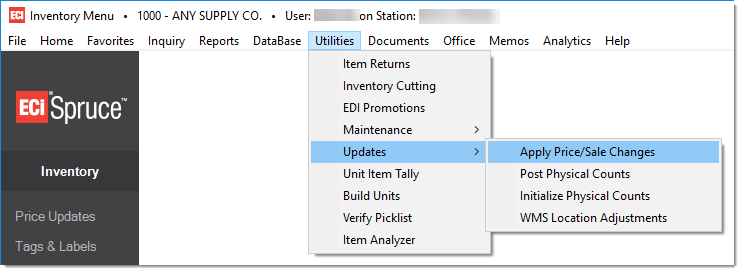Inventory Utilities
The Inventory area's Utilities menu includes a number of inventory related applications
Item Returns
Item Returns is provided for managing either or both stocked and non-stocked returns processed using the enhanced returns feature (enhanced returns may be enabled separately for both stocked and non-stocked items).
Inventory Cutting
Inventory Cutting (also available from Point of Sale) can be used to take a "cut" item, remove a quantity from stock, and re-add the cut goods as other dimensional items.
EDI Promotions
EDI Promotions is used to process sale pricing from a data file provided by a vendor.
Maintenance Menu
The Inventory > Utilities > Maintenance sub-menu provides additional maintenance-specific options whose access should be limited to users who need to perform specific tasks. Click this link to learn more about these options.
Updates (Menu)
The Inventory area's Utilities menu offers a sub-menu named Updates that currently provides three (3) options: Apply Price/Sale Changes, Post Physical Counts, and Initialize Physical Counts.

Apply Price/Sale Changes is used for updating item records with pricing changes by date. This is used for both price changes and sale pricing.
Post Physical Counts is the final step in a full physical inventory (count of all perpetual inventory at a location). Posting takes counted quantities and adjusts the on-hand in the item database to match when necessary.
Initialize Physical Counts is sometimes the first step when a performing a full physical inventory if items that are not counted should be adjusted to a zero on-hand when the physical inventory is completed. Initializing is optional. If not done, items with an on-hand that are not counted are not adjusted and remain unchanged.
This utility provides the ability to adjust the "located" quantity for items with WMS locations if there is any non-located (unallocated) quantity available. WMS (Warehouse Management) is an optional feature that allows the tracking of quantities by location.
Unit Item Tally (Inventory Unit Item Maintenance)
The Inventory Unit Item Maintenance feature provides four (4) functions that relate to unit tally items: Update Unit Info, Change Unit Quantities, Split - Create New Unit, and Break Unit. A "unit tally" is used with products with some dimensional aspect, meaning they are measured by volume, area, or lineal length, and are packaged together and treated as a single "unit" rather than individual components.
Build Units
This utility provides the ability to allocate existing stock (inventory) to a new Unit. This is identical to the process involved when receiving a "unit" as part of a purchase; however, the stock is allocated from the existing on-hand quantities for the involved items.
Verify PickList
The Verify Picklist form provides a visual reference for comparing an existing document with the inventory being pulled for fulfilling staging, delivery, or other requirements.
Aggregator Maintenance
You can use the Aggregator feature to quantify your inventory for many different purposes. The Aggregator Maintenance utility gives you a way to tie inventory to the aggregator types you have created.
IME Pricing
The IME Pricing utility provides data exchange with IME, "Intelligent Margin Enhancement," a service/product of Group CBF, Inc. This menu item only displays when IME Pricing is enabled by Support.
Item Analyzer
The Item Analyzer utility compares a vendor's catalog records with matching items in your inventory. This tool can be used to identify differences between the two (2) items easily. This menu item only displays when Item Analyzer is enabled by Support.
Lost Sales
The Lost Sales utility provides a way of recording products that your company could have sold but was not able to for one reason or another. The purpose of this feature is to provide the ability to track potential losses of business or identify new opportunities. This menu item only displays when Lost Sales is enabled by Support.
Signage Designer
Use the Signage Designer tool to create your own custom promotional signs.
Create a Template
Allows you to create a template for a sign.
Edit an Existing Template
Allows you to edit a sign template you have already created.
Tags & Labels
Use the Tags & Labels utility to print bin labels, price tags, or special order labels on supported models of Zebra™ and DYMO® brand label printers.
Label Designer
Use the Label Design (F6) function to create your own custom label formats
Promotional Signs
Use the Promotional Signs utility to print promotional signs for pending sale pricing, price updates, and inventory item price changes. This menu item only displays when Promotional Signs is enabled by Support.